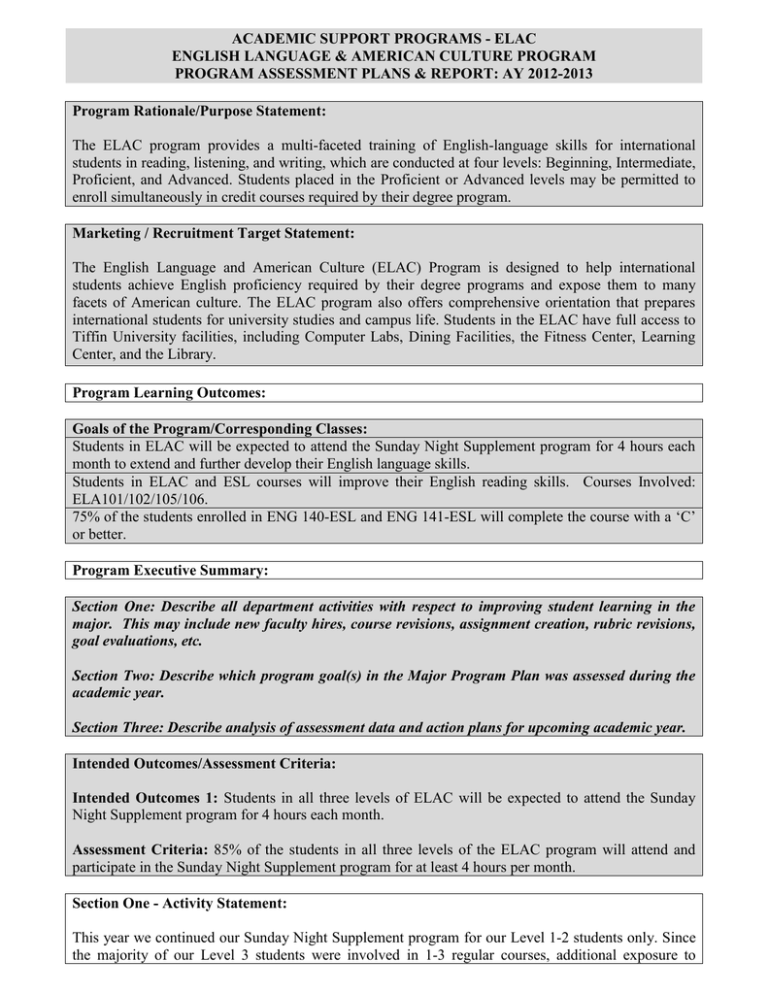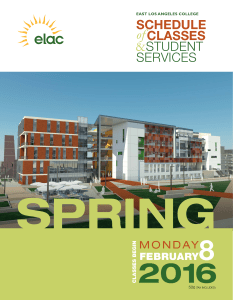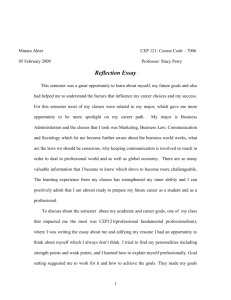Report - Tiffin University
advertisement

ACADEMIC SUPPORT PROGRAMS - ELAC ENGLISH LANGUAGE & AMERICAN CULTURE PROGRAM PROGRAM ASSESSMENT PLANS & REPORT: AY 2012-2013 Program Rationale/Purpose Statement: The ELAC program provides a multi-faceted training of English-language skills for international students in reading, listening, and writing, which are conducted at four levels: Beginning, Intermediate, Proficient, and Advanced. Students placed in the Proficient or Advanced levels may be permitted to enroll simultaneously in credit courses required by their degree program. Marketing / Recruitment Target Statement: The English Language and American Culture (ELAC) Program is designed to help international students achieve English proficiency required by their degree programs and expose them to many facets of American culture. The ELAC program also offers comprehensive orientation that prepares international students for university studies and campus life. Students in the ELAC have full access to Tiffin University facilities, including Computer Labs, Dining Facilities, the Fitness Center, Learning Center, and the Library. Program Learning Outcomes: Goals of the Program/Corresponding Classes: Students in ELAC will be expected to attend the Sunday Night Supplement program for 4 hours each month to extend and further develop their English language skills. Students in ELAC and ESL courses will improve their English reading skills. Courses Involved: ELA101/102/105/106. 75% of the students enrolled in ENG 140-ESL and ENG 141-ESL will complete the course with a ‘C’ or better. Program Executive Summary: Section One: Describe all department activities with respect to improving student learning in the major. This may include new faculty hires, course revisions, assignment creation, rubric revisions, goal evaluations, etc. Section Two: Describe which program goal(s) in the Major Program Plan was assessed during the academic year. Section Three: Describe analysis of assessment data and action plans for upcoming academic year. Intended Outcomes/Assessment Criteria: Intended Outcomes 1: Students in all three levels of ELAC will be expected to attend the Sunday Night Supplement program for 4 hours each month. Assessment Criteria: 85% of the students in all three levels of the ELAC program will attend and participate in the Sunday Night Supplement program for at least 4 hours per month. Section One - Activity Statement: This year we continued our Sunday Night Supplement program for our Level 1-2 students only. Since the majority of our Level 3 students were involved in 1-3 regular courses, additional exposure to English did not seem necessary. Our Level 1-2 students were required to meet for SNS sessions twice a month for a total of four hours. These sessions were organized and facilitated by an assigned tutor who had previous experience working under the tutor that ran the SNS program for the international students during the last academic year. We implemented the program format that we had decided on at the end of the last academic year, splitting the students by their level, so instruction could be differentiated according to their academic skills. Level 1 students met with the tutor from 5-7PM, and Level 2 met from 7-9pm. During the course of both semesters, the students were exposed to various lessons that integrated content instruction and discussions focused on cultural events, communication skills, and grammar/writing techniques. In the fall, Sunday Night Supplement was held every week, and the students were required to choose at least two sessions each month to attend for a total of four hours per month. In the spring, we decided to revise the schedule and offer only two sessions every month that each student was required to attend. The content and instruction was also modified based on student suggestions and feedback about particular issues and skills with which they were struggling. Section Two - Results of Outcomes Activity: 2012-2013 Met/Not Met Data Details SNS goal – Met in Fall 12 Records of SNS and conversation table attendance were kept every 85% of the Not Met in week. For the Fall 2012 semester, these records indicate that 92% of students in all Spring 13 the ELAC students in levels 1-2 attended at least 4 hours per month. three levels of Six of the students attended 6-8 hours per month, exceeding the the ELAC required time allotment. For the Spring 2012 semester, these records program will indicate that only 75% of the ELAC students in levels 1-2 attended at attend and least 4 hours per month. participate in the Sunday Night Supplement program for at least 4 hours per month. Section Three - Analysis and Action Plans: Analysis: The difference in Sunday Night Supplemental instructions program attendance rates from the Fall to the Spring were most likely due to the revised schedule that provided only two opportunities a month rather than four. It seems that the benefits and drawbacks of both schedules need to be considered to determine which schedule is best. The SNS sessions were required by multiple professors at each level, but this did not seem to motivate all of the students in the Spring since 3 of the 9 students missed 3 sessions. On the other hand, the revised schedule was more convenient for the tutors and the instructors, and it provided more consistency in terms of attendance and participation. Overall, the SNS program continues to be a successful and necessary aspect of our ELAC education program because it provides additional one-on-one instruction outside the classroom that is guided by student feedback and instructor support. The additional contact hours are also helpful for international students who benefit from repeated exposure to the English language. Action Plan: After examining the two previous schedules and the pros and cons that both had to offer, we decided to adhere to the schedule implemented in the spring. Although attendance dropped with this schedule, we still believe that the benefits of a scheduled set of dates outweigh the alternative. We have decided that these SNS sessions will be an academic requirement of the ELA reading courses at both levels. This may provide some consistency for the students that will help promote a higher level of attendance. Due the success of this program, we would also like to add more contact hours outside the classroom for our Level 1-2 students; some possibilities include opportunities to volunteer in the community and/or helping out in the local school districts. We are in the process of coordinating and organizing this with the local school district superintendent. Intended Outcomes 2: Students in ELAC courses will improve their English reading skills. Courses Involved: ELA101/105 (Level 1) and 102/106 (Level 2). Assessment Criteria: Students in the listed courses will take the Accuplacer tests at the end of each semester. 75% of them will show an increase of at least 5 points between the first and second tests. Section One - Activity Statement: Together with the international students office, the ELAC department continued to work together to prepare for the application process involved with receiving accreditation as a stand-alone Intensive English Program. As we began this process, several issues surfaced that led to some changes to our classes in Levels 1-3. After evaluating the needs of our current and growing international population, we decided to remove the Level 1 ELA 107 and Level 2 ELA 108 American Culture classes. The new curriculum that we have adopted in those levels sufficiently covers aspects of American culture through the reading, writing, and communication instruction. We also decided to add a level 2 grammar course (ELA 112) because the students at this level still needed instruction and reinforcement of grammar concepts in order to be properly prepared for Level 3 and possible exposure to regular classes. At Level 3, we added ELA 130, a communications class designed for advanced students in the development and improvement of communication and listening skills needed to successfully participate and contribute in an academic learning environment. This would better serve our graduate students who would be moving on to graduate learning environments where communication with professors and in group situations was expected at a higher academic level. In personnel, a new adjunct professor with an ESL background who is fluent in Arabic was hired to help fill the slots for our new classes and assist with our growing Middle Eastern population. The remaining professors were utilized based on their strengths and qualifications in the relevant areas. An effort was made to schedule all of the ELAC classes in the same building area for the ease and convenience of both the students and the professors. A document camera was purchased for use in the Level 2 classroom to aid in instruction and presentation of content. In addition, various cultural events were planned for our Level 1-2 students to help with their transition to our culture and to encourage the sharing of their own culture. We envisioned that these changes would aid in the preparation and education of our international students as they progress through Levels 1-3 of our ELAC program. Due to changes in faculty in our reading and writing courses during the semester, we decided to continue using the Accuplacer scores to assess reading progress. Section Two - Results of Outcomes Activity: 2012-2013 Met/Not Met Data Details Students in the Met in Fall Students in Levels 1 and 2 took the Accuplacer test at the beginning listed courses 2012 and of the fall semester and again at the end of the fall semester in 2012. will take the Spring 2013 This testing was repeated at the beginning and end of spring Accuplacer at semester in 2013. After comparing scores, 87% of the students the end of each improved their Accuplacer scores by 5 points or more, with 60% semester. 75% improving by 15 points or more and 40% improving by 20 points or of them will show an increase of at least 5 points between the first and second tests. more. Section Three - Analysis and Action Plans: Analysis: There was a significant increase in this year’s results compared to the percentages represented by last year’s testing results (only 45% of students improved by 5 points or more). A likely contribution to this marked improvement was the consistency of curriculum and faculty that was maintained during the course of the semester. Especially notable is the high percentages of students whose scores increased by 15 or 20 points within the course of one semester. This suggests that the coursework and instruction of the targeted ELA courses is having a positive effect on the reading skill level of the students. Action Plan: In order to continue this success, we will make no changes to the current curriculum since it seems to be having the desired efffect. Unfortunately, we are losing two faculty members that were both highly qualified and very experienced professionals; therefore, an effort will be made to ensure that their replacements will be equally suitable for those vacated positions. One experienced faculty member has been hired to teach four of the open courses, and we are currently searching for other options to fill the remaining open courses. Intended Outcomes 3: 75% of the students enrolled in ENG 140-ESL and ENG 141-ESL will complete the course with a ‘C’ or better on their first attempt. Assessment Criteria: Determine the number of first-time students enrolled in the ESL section of ENG 140 and 141 in fall and spring semesters. Establish the number of those students who earn a ‘C’ or better in the courses. Section One - Activity Statement: Due to some continued issues related to the preparation of our graduate international students for their respective degrees, it was decided that there needed to be a fourth level of instruction (reading, writing, research, and communication) for graduate students before they begin their Master’s. This led to the creation of two courses, ELA 541 and 542. ELA 541 was designed as a comprehensive introduction to research writing at the graduate level for those ESL students who are not proficient in academic research and documentation. ELA 542 was created as a practicum course that required students to gain a minimum of 150 hours of volunteer or paid practicum experience related to their chosen field that would familiarize them with American culture while improving their proficiency in the areas of academic and professional communication. The international versions the ENG 140 and ENG 141 are typically the most critical courses for our ELAC students because success in these foundational writing and research classes equip them with the necessary skills needed for success in their future coursework. For this reason, we have altered our goal to include both courses. In addition, these two classes saw a substantial increase in class enrollment this academic year, prompting the adding of a second teacher for the ENG 140 class in the fall and the adding of 2nd section of ENG 141 in the spring. There was some concern about these growing class sizes because the international sections of these English courses need to remain small, so the proper accommodations and differentiation can be successfully implemented. Both courses (ENG 140 and 141) had previously required students to attend Supplemental Instruction sessions and Student Success Center workshops for a portion of their grade. This year, the university rescinded those requirements, allowing teachers to assign them extra credit points only. There was some concern about the effect this might have on student utilization of these academic support programs. Section Two - Results of Outcomes Activity: 2012-2013 Met/Not Met Data Details 75% of the Met An average of 76% of the students enrolled in both ENG 140-ESL students and ENG 141-ESL completed the courses with a “C” or better. In enrolled in Fall 2012, 77% of students in ENG 140 passed and 67% of students ENG 140in ENG 141 passed. In Spring 2013, 95% of students in ENG 140 ESL and 141passed and 72% of students in ENG 141 passed. These percentages ESL will average to a total of 76% overall. complete the course with a ‘C’ or better. Section Three - Analysis and Action Plans: Analysis: The meeting of this goal is again most likely due to the consistency that was maintained in terms of content and instruction. The same professors and texts were used throughout the course of the academic year, as well as the same online grammar component (for the two different levels) and the same online platform used for assignments and grading (eCollege). Action Plan: After much discussion this academic year about the tendency of students to struggle more in ENG 141, it was discovered that the issue was closely connected to their resistance to academic reading. International students who are accepted to the university with an acceptable language proficiency score are required to test for possible remediation courses in writing (ENG 140), but not for reading. We know that it would be helpful for most of these students and other undergraduates if they were tested and placed in a required, remedial reading course focused on their particular major. We will write a proposal this summer for a remedial reading course that would be required for any undergraduate student (international students included) that tested into it. The large enrollments in ENG 140 and 141 have already prompted the addition of another international section of each course in the Fall and Spring of next year. It was also decided that it would be most beneficial for ENG 140 students if the split was made based on their post-secondary level; therefore, we will have a graduate and undergraduate section of ENG 140. This will allow the professor of the graduate section to alter the curriculum in a way that better prepares the students for graduate coursework. The implementation of ELA 541 this academic year has been very successful; the need for the course has been overwhelmingly evident. Because ELA 541 serves the same purpose for graduate students as ENG 141 serves for undergraduate students, next year it will be added to this particular outcome activity for assessment as well. In addition, due to logistical and quality of experience issues, we have decided to revise the ELA 542 course format. Instead of a practicum, work-related field experience, the new format will be a classroom setting where students will be exposed to multiple cultural, academic, group, and community activities and settings designed to improve their overall communication and increase their exposure to professional settings. Updated May 2013





